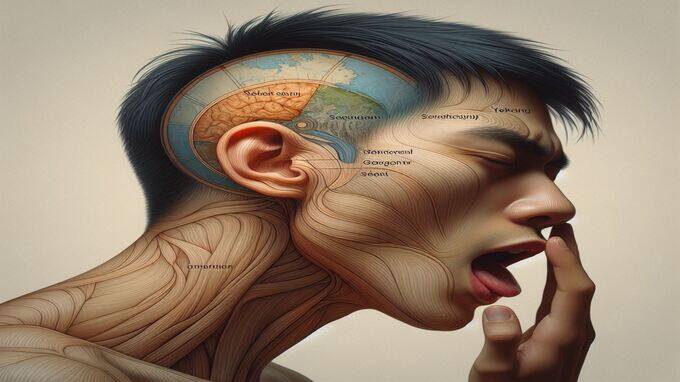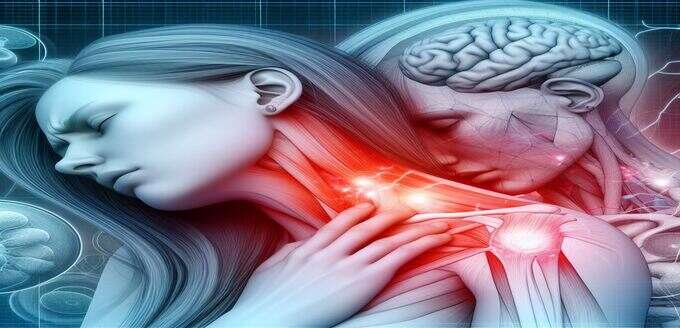Geographic Tongue

Have you ever looked in the mirror and noticed unusual, map-like patches on your tongue? This surprisingly common condition is called geographic tongue. While its appearance might be startling, it’s entirely benign and usually painless. Let’s delve into what geographic tongue is, its history, and why it occurs.
What is Geographic Tongue?
Geographic tongue is characterized by smooth, reddish patches on the tongue’s surface, often surrounded by slightly raised, white borders. These resemble islands and continents on a map, hence the name.
The patches aren’t static. They tend to heal in one area while new ones appear elsewhere, creating an ever-changing “map” on the tongue’s surface.
Most people with geographic tongues experience no pain or discomfort. There might be mild sensitivity to spicy, acidic, or hot foods.
Geographic Tongue History
- Medical texts dating back centuries describe conditions matching the appearance of geographic tongue.
- The term “geographic tongue” was first coined in the 1800s and has been used in medical literature ever since.
- While recognized long ago, the exact causes of geographic tongue continue to be investigated by scientists, with several potential contributing factors emerging.
Geographic Tongue Frequency
Geographic tongue is relatively common, with estimates suggesting it affects around 1-3% of the general population worldwide.
- While it can appear at any age, it’s more frequent in children and young adults. Women are affected more often than men.
- Geographic tongue exists on a spectrum. Some people have occasional mild patches, while others experience more extensive and noticeable changes.
- Many cases need to be noticed or are mistaken for other conditions, making accurate estimates of their prevalence tricky.
Geographic Tongue Symptoms
Geographic tongue, scientifically termed benign migratory glossitis, stands as a fascinating disorder within the realm of oral health. Its unique presentation, marked by irregular patterns and shifting landscapes on the tongue’s surface, beckons exploration and understanding. In this comprehensive discourse, we journeyed to unravel the intricate symptoms and sensory experiences associated with geographic tongue, shedding light on its complexities and nuances.
Irregular Patches
At the heart of the geographic tongue’s manifestation are irregular patches that adorn the tongue’s surface. These patches, reminiscent of miniature cartographic landscapes, exhibit various shapes, sizes, and colors. Some patches appear smooth, red areas, while others boast distinctive white-bordered contours. The interplay of these patches creates a visually striking tapestry that sets geographic tongue apart from the uniformity of healthy oral mucosa.
The irregularity of these patches often prompts individuals to inspect their tongues closely, intrigued by the patterns that emerge. Each patch tells a story of its own, contributing to the overall mosaic that defines the geography of the tongue.
Shifting Patterns
What distinguishes a geographic tongue is its dynamic and migratory nature. Unlike static oral conditions, the patches of geographic tongue embark on a journey of exploration, traversing the tongue’s terrain with fluidity and unpredictability. This phenomenon, known as migratory glossitis, adds an element of intrigue and unpredictability to the condition.
As individuals observe their tongues over time, they may notice subtle shifts in the arrangement and distribution of patches. A patch that once occupied the tip of the tongue may migrate to the lateral edges or disappear entirely, only to reappear in a different location. This transient nature of geographic tongue leaves a trail of fleeting impressions, challenging conventional notions of stability within oral pathology.
Varied Pigmentation
Within the vibrant canvas of geographic tongue, diversity thrives in the form of varied pigmentation. While the dominant hue may be red, the patches exhibit a rich spectrum of colors, ranging from white and yellow to subtle shades of grey. This chromatic variability adds depth and complexity to the visual landscape of the tongue, transforming it into a canvas of artistic expression.
The interplay of light and shadow across the patches creates a visual spectacle that captivates the observer’s gaze. Each hue tells a story, reflecting the intricate interplay of the oral cavity’s physiological processes and environmental influences.
Sensory Whispers

Although the geographic tongue is typically benign, it may occasionally evoke discomfort or sensitivity in affected individuals. Certain stimuli, such as spicy or acidic foods, may exacerbate irritation within the patches, leading to transient discomfort or a tingling sensation. While these sensations are generally mild and short-lived, they serve as reminders of the condition’s presence and prompt individuals to exercise caution when selecting foods or beverages.
For some individuals, discomfort may extend beyond physical sensations to emotional or psychological responses. The visibility of the geographic tongue may evoke feelings of self-consciousness or concern, particularly in social or professional settings. However, with education and awareness, individuals can navigate these challenges with resilience and confidence, recognizing geographic tongue as a benign and manageable condition.
Asymptomatic Calm
Beneath its visually captivating facade, the geographic tongue often conceals itself in a veil of asymptomatic calm. Many individuals remain unaware of its presence, as it quietly inhabits their oral terrain without eliciting notable discomfort or disruption. This silent demeanor adds an element of intrigue and mystery to the condition, allowing it to elude detection until a curious gaze happens upon its distinctive markings.
The asymptomatic nature of geographic tongue underscores its benign and self-limiting course, reassuring individuals of its non-threatening nature. However, for healthcare professionals, the challenge lies in distinguishing geographic tongue from other oral conditions that may present with similar symptoms. Differential diagnosis may require a thorough evaluation of clinical findings, medical history, and additional diagnostic tests to rule out other potential causes of tongue abnormalities.
The symptoms and sensations of geographic tongue offer a captivating glimpse into the complexities of oral health. From the patchwork canvas of irregular patches to the nomadic journey of shifting patterns, each characteristic contributes to the enigmatic nature of this condition. As we explore the spectrum of hues and sensory whispers associated with geographic tongue, we gain a deeper understanding of its intricacies and nuances.
Despite its visual intrigue and occasional sensations of discomfort, geographic tongue remains a benign and manageable condition for most individuals. Through education, awareness, and appropriate management strategies, affected individuals can navigate the terrain with confidence and resilience. By unraveling the mysteries of geographic tongue, we pave the way for greater understanding and acceptance within the realm of oral pathology.
Geographic Tongue Causes
The geographic tongue, also called benign migratory glossitis, presents a fascinating puzzle within the domain of oral health. Its distinctive appearance, characterized by irregular patches on the tongue’s surface, has intrigued researchers and healthcare professionals for decades. While the symptoms of geographic tongue are well-documented, its underlying causes remain a subject of ongoing investigation. In this comprehensive exploration, we delve into the multifaceted web of factors that may contribute to the development of geographic tongue, shedding light on the potential triggers and mechanisms at play.
Genetic Factors
A strong genetic component is at the core of the discussion surrounding the causes of geographic tongue. Research indicates that individuals with a family history of the condition are more likely to develop a geographic tongue. This suggests an underlying hereditary predisposition that influences the susceptibility to geographic tongue within certain populations.
The genetic underpinnings of geographic tongue are complex, involving interactions between multiple genes and environmental factors. Studies have identified several genetic variations associated with an increased risk of geographic tongue, although the precise mechanisms by which these genes contribute to the condition remain incompletely understood. Further research is needed to elucidate the genetic pathways involved in developing a geographic tongue and their interactions with environmental triggers.
Hormonal Changes

Hormonal fluctuations have emerged as another potential contributor to the development of geographic tongues, particularly in women. Women may experience changes in the prevalence or severity of geographic tongue during periods of hormonal upheaval, such as puberty, pregnancy, or menopause. The hormonal fluctuations associated with these life stages can influence the immune system and mucosal tissues, potentially predisposing individuals to the geographic tongue.
Estrogen and progesterone, two key hormones involved in the female reproductive cycle, have been implicated in the pathogenesis of geographic tongue. These hormones play a role in modulating immune responses and inflammatory processes, which may contribute to developing or exacerbating geographic tongue symptoms. However, further research is needed to elucidate the specific mechanisms by which hormonal changes influence the onset and progression of geographic tongue.
Autoimmune Factors
Autoimmune conditions represent another avenue of inquiry in the search for the causes of geographic tongue. Research suggests that individuals with autoimmune diseases, such as psoriasis and lichen planus, may be at increased risk of developing geographic tongue or experiencing exacerbations of existing symptoms. These conditions involve immune system dysregulation, leading to inflammation and tissue damage in various body parts, including the oral mucosa.
The precise mechanisms by which autoimmune factors contribute to the development of geographic tongues are not fully understood. However, it is believed that immune dysregulation and aberrant inflammatory responses may play a role in the pathogenesis of the condition. Further research is needed to elucidate the specific immune pathways involved in geographic tongue and identify potential therapeutic targets for intervention.
Stress and Emotional Factors
Psychological stress and emotional factors have long been recognized as potential triggers for various oral conditions, including geographic tongue. Stressful life events, anxiety, and depression may exacerbate existing symptoms of geographic tongue or increase the likelihood of experiencing flare-ups. The exact mechanisms by which stress influences the development of geographic tongue are not fully understood but may involve alterations in immune function, hormonal responses, or oral microbial balance.
Stress can trigger a cascade of physiological responses in the body, including releasing stress hormones such as cortisol and adrenaline. These hormones can modulate immune function and inflammatory processes, potentially impacting the severity of geographic tongue symptoms. Additionally, stress may lead to changes in oral habits, such as teeth grinding or nail-biting, which can further exacerbate oral mucosal irritation and inflammation.
Dietary Factors
Certain dietary factors have been implicated as potential triggers for geographic tongue, although the evidence is limited and anecdotal. Spicy, acidic, or rough-textured foods and beverages are often cited as common culprits that may exacerbate symptoms or provoke transient discomfort in individuals with a geographic tongue. While the exact mechanisms underlying this relationship are not fully understood, it is believed that certain foods’ abrasive or irritating nature may contribute to inflammation or irritation of the oral mucosa.
Individuals with geographic tongues may find relief by avoiding known dietary triggers and adopting a soft, bland diet that minimizes irritation to the tongue. However, dietary modifications should be cautiously approached and tailored to individual preferences and tolerances. Consulting with a healthcare professional or registered dietitian can help individuals with geographic tongue identify potential dietary triggers and develop a nutrition plan that supports oral health and overall well-being.
Nutritional Deficiencies
Nutritional deficiencies, particularly deficiencies in vitamins and minerals essential for oral health, may play a role in the development of geographic tongue. Research suggests deficiencies in nutrients such as vitamin B12, folate, zinc, and iron may be associated with an increased risk of oral mucosal abnormalities, including geographic tongue. Adequate nutrition is essential for maintaining the integrity of oral tissues and supporting immune function, reducing the likelihood of developing oral conditions such as geographic tongue.
Individuals with geographic tongues may benefit from incorporating nutrient-rich foods into their diet to address potential deficiencies and support oral health. Foods rich in vitamin B12, folate, zinc, and iron include lean meats, poultry, fish, eggs, dairy products, leafy green vegetables, legumes, nuts, and seeds. In some cases, dietary supplements may be recommended to address specific nutrient deficiencies, although healthcare professionals should guide supplementation to ensure safety and efficacy.
Environmental Factors
Environmental factors, such as exposure to certain allergens, irritants, or toxins, may also contribute to developing a geographic tongue. Individuals with sensitivities to certain substances, such as certain foods, medications, or oral care products, may experience exacerbations of geographic tongue symptoms upon exposure. Additionally, environmental factors such as climate or air pollution may indirectly influence the prevalence or severity of geographic tongue through their effects on overall health and immune function.
Avoiding known environmental triggers and maintaining good oral hygiene practices can help minimize the risk of exacerbating geographic tongue symptoms. Individuals with geographic tongues should be mindful of their surroundings and take steps to reduce exposure to potential irritants or allergens. Consulting with a healthcare professional can guide identifying and managing environmental triggers to support oral health and well-being.
The causes of geographic tongue are multifaceted and complex, involving a combination of genetic, hormonal, autoimmune, environmental, dietary, and nutritional factors. While significant progress has been made in understanding the underlying mechanisms of geographic tongue, much remains to be learned about its pathogenesis and potential therapeutic interventions. Further research is needed to elucidate the specific genetic, immunological, and environmental factors that contribute to the development of geographic tongues and identify novel approaches for prevention and management. By unraveling the mysteries of the geographic tongue’s etiology, we can pave the way for more targeted and effective strategies to address this enigmatic condition.
Geographic Tongue Impacts
Geographic tongue, a condition characterized by irregular patches on the tongue’s surface, may seem benign at first glance. However, for those who experience it, the impacts can extend beyond the physical symptoms. In this article, we delve into the multifaceted implications of geographic tongue, exploring its effects on various aspects of life and providing insights into coping strategies for individuals navigating this condition.
Physical Discomfort and Sensitivity

At the forefront of the impacts of geographic tongue is the physical discomfort and sensitivity it can cause. The irregular patches on the tongue’s surface may be sensitive to certain foods, beverages, or oral hygiene practices, leading to sensations of irritation or discomfort. Spicy, acidic, or rough-textured foods, in particular, may exacerbate existing symptoms, making eating and drinking a potentially uncomfortable experience for individuals with geographic tongues.
Additionally, the transient nature of the geographic tongue, characterized by the migration of patches across the tongue, can contribute to ongoing sensations of discomfort and uncertainty. Individuals may find themselves constantly vigilant, anticipating the onset of symptoms or changes in the appearance of their tongues. This heightened awareness can be emotionally taxing, adding stress to daily life.
Social and Emotional Impact
Beyond the physical discomfort, geographic tongue can also have social and emotional implications for affected individuals. The visible nature of the condition may elicit feelings of self-consciousness or embarrassment, particularly in social or professional settings where appearance plays a significant role. Individuals may worry about how others perceive their tongues or fear being judged or stigmatized by their condition.
The unpredictability of the geographic tongue, with its ever-shifting patterns and transient nature, can further exacerbate feelings of anxiety or distress. Individuals may struggle to predict when symptoms will flare up or how long they will persist, leading to uncertainty and loss of control. These emotional challenges can impact various aspects of life, from interpersonal relationships to professional endeavors, potentially affecting self-esteem and overall well-being.
Oral Health Impact
Geographic tongue can also present challenges in terms of oral health management. The irregular patches on the tongue’s surface may make oral hygiene practices, such as brushing and flossing, more difficult or uncomfortable. Individuals may find cleaning around the affected areas challenging, potentially increasing the risk of plaque buildup, tooth decay, or gum disease.
Furthermore, the sensitivity of geographic tongue to certain foods or oral care products may limit individuals’ options for maintaining oral hygiene. They may need to avoid certain toothpaste ingredients or mouthwashes that exacerbate symptoms, leading to difficulties finding suitable products that effectively clean the mouth without irritating.
The impacts of geographic tongue extend beyond the physical symptoms, encompassing social, emotional, and oral health considerations. For those affected by this condition, navigating daily life may require resilience, adaptability, and support from healthcare professionals and loved ones.
By understanding the challenges posed by geographic tongue and implementing personalized coping strategies, individuals can minimize the impacts of the condition on their quality of life. With proper management and support, individuals with geographic tongues can continue to lead fulfilling lives, embracing their uniqueness and navigating the challenges with resilience and determination.
Geographic Tongue Diagnosis
Geographic Tongue or benign migratory glossitis presents a curious puzzle for healthcare professionals. Its characteristic irregular patches and shifting patterns on the tongue’s surface make diagnosis a nuanced endeavor. In this comprehensive exploration, we delve into the intricacies of diagnosing geographic tongue, uncovering the methods and tests employed to unravel this enigmatic condition.
Visual Examination
The cornerstone of diagnosing geographic tongue lies in the art of visual examination. Healthcare professionals, often dentists or oral healthcare providers, meticulously inspect the tongue’s surface to identify hallmark signs of the condition. They scrutinize the irregular patches, noting their size, shape, color, and distribution.
During this examination, healthcare professionals observe the transient nature of geographic tongue, as patches may shift and change over time. The distinctive borders separating the affected areas from healthy tissue serve as crucial diagnostic clues, helping differentiate geographic tongue from other tongue abnormalities.
Differential Diagnosis
While the visual appearance of the geographic tongue is often characteristic, healthcare professionals must navigate through a differential diagnosis to rule out other potential causes of tongue irregularities. Conditions such as oral thrush, oral lichen planus, candidiasis, or psoriasis may present with similar visual cues, requiring careful consideration and clinical judgment.
Healthcare professionals delve into the patient’s medical history, symptoms, and risk factors to distinguish geographic tongue from its counterparts. They may inquire about recent changes in oral hygiene practices, dietary habits, or exposure to potential irritants. Additionally, they may perform further tests or procedures to confirm the diagnosis and rule out alternative explanations for the tongue’s appearance.
Biopsy
In cases where the diagnosis remains uncertain or other conditions are suspected, a biopsy may be warranted to obtain a definitive diagnosis. During a biopsy, a small tissue sample is extracted from the affected area of the tongue and sent to a laboratory for microscopic examination.
A biopsy provides valuable insights into the histological features of a geographic tongue, confirming the presence of characteristic inflammatory changes or tissue alterations. It also helps exclude other potential causes of tongue abnormalities, guiding healthcare professionals in treatment decisions and management strategies.
Clinical Tests
While geographic tongue is often considered a benign condition, healthcare professionals may conduct additional clinical tests to explore underlying factors contributing to its development. Blood tests, allergy testing, and autoimmune markers may be employed to assess for potential systemic conditions or triggers associated with geographic tongue.
Blood tests can reveal nutritional deficiencies, hormonal imbalances, or autoimmune disorders that may be linked to geographic tongue. Allergy testing can identify potential allergens or sensitivities exacerbating symptoms, while autoimmune markers can detect underlying autoimmune conditions coexisting with or predisposing individuals to the geographic tongue.
Imaging Studies
In rare instances where the geographic tongue is suspected to be associated with structural changes or abnormalities in the oral cavity, imaging studies such as X-rays, CT scans, or MRI scans may be recommended for further evaluation. These imaging modalities enable healthcare professionals to peer beneath the surface, assessing for underlying structural abnormalities or lesions.
Imaging studies provide valuable insights into the anatomical characteristics of the oral cavity, aiding in treatment planning and monitoring for potential complications. While not routinely required for diagnosing geographic tongue, these tests may be invaluable in cases where underlying structural or systemic abnormalities are suspected.
Diagnosing the geographic tongue demands a comprehensive approach that integrates visual examination, differential diagnosis, biopsy, clinical tests, and, occasionally, imaging studies. By meticulously evaluating the symptoms and characteristics of the tongue, healthcare professionals can arrive at an accurate diagnosis and devise tailored management plans.
Early diagnosis and appropriate intervention are crucial for individuals with geographic tongues to ensure optimal outcomes and quality of life. Through a thorough understanding of the diagnostic process and tests employed, healthcare professionals can navigate the complexities of geographic tongue with precision and efficacy, guiding patients on their journey toward oral health and well-being.
Geographic Tongue Treatment
Geographic tongue, though benign, can present significant discomfort and challenges in daily life. While there’s no cure, understanding effective treatment strategies can alleviate symptoms and improve overall well-being. In this detailed exploration, we delve into comprehensive approaches for treating geographic tongue, covering oral hygiene practices, dietary adjustments, symptomatic relief, stress management, and long-term monitoring.
Oral Hygiene Practices
Robust oral hygiene practices form the cornerstone of managing geographic tongue. Regular brushing with a soft-bristled toothbrush, focusing on gentle strokes to clean the tongue’s surface, is crucial. Proper tongue cleaning helps remove debris and bacteria, reducing the risk of irritation and inflammation.
Selecting oral care products wisely is key. Opting for mild, non-irritating toothpaste and alcohol-free mouthwash formulations can prevent further discomfort. These products should be free from abrasive ingredients, ensuring gentle care for the sensitive tongue.
Dietary Adjustments
Modifying the diet can significantly alleviate discomfort associated with geographic tongue. Steering clear of spicy, acidic, or rough-textured foods and beverages is advisable to minimize irritation. Instead, softer, bland foods reduce the likelihood of aggravating symptoms.
Balanced nutrition is pivotal. Ensuring adequate intake of vitamins and minerals—especially vitamin B12, folate, zinc, and iron—supports oral health and immune function. Incorporating nutrient-rich foods like lean meats, leafy greens, and legumes aids in addressing potential deficiencies.
Symptomatic Relief
Topical treatments prove effective for immediate relief from discomfort. Over-the-counter oral pain relievers, including topical anesthetics and analgesic gels, numb affected areas temporarily, easing pain and discomfort.
Healthcare professionals may prescribe topical corticosteroids to alleviate inflammation and irritation in severe or persistent cases. Applied directly to the tongue, these medications provide significant relief when used as directed.
Stress Management
Managing stress is integral to coping with geographic tongue. Incorporating relaxation techniques such as deep breathing exercises, meditation, or yoga into daily routines promotes emotional well-being and reduces stress.
Seeking support from peers, family, or support groups fosters resilience. Connecting with individuals who share similar experiences provides a sense of community and encouragement, aiding in navigating the emotional challenges of living with a geographic tongue.
Regular Monitoring
While there’s no cure for the geographic tongue, ongoing monitoring and follow-up care are essential. Regular check-ups with healthcare professionals allow for assessing symptoms and adjusting treatment strategies as needed.
Vigilance for oral complications—such as infections or lesions—is crucial. Promptly seeking medical attention for any concerning signs ensures early detection and intervention, preventing complications and optimizing outcomes.
In conclusion, treating geographic tongue requires a comprehensive approach encompassing oral hygiene practices, dietary adjustments, symptomatic relief, stress management, and regular monitoring. By implementing these strategies, individuals can effectively manage symptoms, promote oral health, and enhance overall well-being.
While geographic tongue presents challenges, a tailored treatment plan tailored to individual needs empowers individuals to navigate the condition confidently. With proper management and support, relief from discomfort is achievable, allowing individuals to enjoy improved oral health and quality of life.
10 Famous Personalities with Geographic Tongue
Though commonly encountered, Geographic tongue needs to be discussed more openly. However, several influential personalities from various fields have shed light on their experiences with this oral condition. In this intriguing exploration, we delve deeper into the lives of 10 famous individuals who have bravely shared their encounters with geographic tongue, fostering awareness and understanding.
Scarlett Johansson
Scarlett Johansson, born November 22, 1984, in New York City, is a highly acclaimed actress known for her versatility and captivating performances. Her breakthrough role came in the film “Lost in Translation” (2003), for which she received critical acclaim and won a BAFTA Award for Best Actress. Johansson’s career has since flourished with roles in blockbuster hits such as “The Avengers” series, “Marriage Story,” and “Jojo Rabbit.” Beyond her acting prowess, Johansson is admired for her advocacy work on various social and political issues, including women’s rights and access to healthcare. Despite her success, Johansson has been candid about her struggles with geographic tongue, raising awareness about the condition and encouraging others to prioritize their oral health.
Tom Cruise
Born on July 3, 1962, in Syracuse, New York, Tom Cruise is an iconic actor and producer known for his roles in numerous blockbuster films. Cruise’s career took off in the 1980s with hits like “Top Gun” (1986) and “Rain Man” (1988), solidifying his status as one of Hollywood’s leading actors. Throughout his career, Cruise has starred in action-packed franchises such as “Mission: Impossible” and garnered critical acclaim for his performances in dramas like “Jerry Maguire” (1996) and “Magnolia” (1999). Despite his success in the entertainment industry, Cruise has faced challenges related to his geographic tongue, demonstrating resilience and determination in overcoming obstacles on and off the screen.
Oprah Winfrey
Oprah Winfrey, born on January 29, 1954, in Kosciusko, Mississippi, is a media mogul, talk show host, and philanthropist renowned for her influential television program, “The Oprah Winfrey Show.” With her groundbreaking talk show, Winfrey became one of the most influential figures in the media landscape, tackling various social issues and empowering audiences worldwide. Beyond her television career, Winfrey has ventured into film production, publishing, and philanthropy, establishing herself as a powerful force for positive change. Despite her success, Winfrey has shared her experiences with geographic tongue, advocating for oral health awareness and encouraging others to prioritize self-care.
Miley Cyrus
Born Destiny Hope Cyrus on November 23, 1992, in Nashville, Tennessee, Miley Cyrus rose to fame as a Disney Channel star with her role as Miley Stewart/Hannah Montana in the hit series “Hannah Montana.” Cyrus’s transition from a child star to a mainstream pop sensation was marked by her bold and provocative image, as showcased in her album “Bangerz” (2013). Known for her chart-topping hits like “Wrecking Ball” and “Party in the U.S.A.,” Cyrus has cemented her status as a pop culture icon. Despite her fame, Cyrus has been transparent about her experiences with her geographic tongue, using her platform to promote self-acceptance and encourage others to embrace their uniqueness.
David Beckham

David Beckham, born on May 2, 1975, in London, England, is a retired professional soccer player and global icon. Beckham’s illustrious career saw him play for prestigious clubs such as Manchester United, Real Madrid, and the LA Galaxy, earning numerous accolades and championships. Beyond his accomplishments in the field, Beckham’s influence extends to fashion, philanthropy, and entrepreneurship. Despite his status as a sports legend, Beckham has shared his struggles with geographic tongue, emphasizing the importance of perseverance and determination in overcoming challenges.
Emma Stone
Emily Jean “Emma” Stone, born November 6, 1988, in Scottsdale, Arizona, is an Academy Award-winning actress known for her charismatic performances and versatility. Stone gained widespread recognition for her roles in films such as “Easy A” (2010), “The Help” (2011), and “La La Land” (2016), for which she won the Oscar for Best Actress. Her ability to seamlessly transition between comedic and dramatic roles has solidified her as one of Hollywood’s most sought-after talents. Despite her success, Stone has been forthcoming about her experiences with geographic tongue, advocating for self-care and acceptance in the face of health challenges.
Michael Phelps
Michael Phelps, born on June 30, 1985, in Baltimore, Maryland, is an Olympic swimming legend and the most decorated Olympian ever. Phelps’s remarkable career includes 23 Olympic gold medals, numerous world records, and unparalleled dominance in the pool. Beyond his athletic achievements, Phelps has been candid about his battles with mental health issues and the importance of seeking help when needed. Despite his superhuman feats in the water, Phelps has shared his experiences with a geographic tongue, emphasizing the significance of resilience and determination in overcoming obstacles.
Jennifer Aniston
Jennifer Joanna Aniston, born on February 11, 1969, in Los Angeles, California, is an Emmy Award-winning actress best known for her role as Rachel Green on the iconic “Friends.” Aniston’s portrayal of the beloved character propelled her to international fame and established her as one of Hollywood’s most recognizable faces. Throughout her career, Aniston has starred in many films and television shows, showcasing her talent and versatility as an actress. Despite her success, Aniston has opened up about her experiences with geographic tongue, advocating for oral health awareness and encouraging others to prioritize their well-being.
John Legend
John Roger Stephens, known professionally as John Legend, was born in Springfield, Ohio, on December 28, 1978. Legend is a Grammy-winning musician, singer-songwriter, and actor celebrated for his soulful voice and heartfelt lyrics. His critically acclaimed albums, including “Get Lifted” (2004) and “Once Again” (2006), have garnered widespread acclaim and earned him numerous awards. In addition to his musical endeavors, Legend is known for his activism and advocacy work on social justice issues. Despite his multifaceted career, Legend has shared his experiences with geographic tongue, promoting self-acceptance and confidence in facing health challenges.
Ellen DeGeneres
Ellen Lee DeGeneres, born on January 26, 1958, in Metairie, Louisiana, is a beloved television host, comedian, and actress known for her eponymous talk show, “The Ellen DeGeneres Show.” DeGeneres’s groundbreaking program has won numerous Emmy Awards and earned acclaim for its positive and uplifting content. Beyond her television career, DeGeneres is passionate about animal rights and LGBTQ+ rights. Despite her success, DeGeneres has addressed her experiences with geographic tongue, using her platform to educate and uplift others facing similar challenges.
In conclusion, the lives of these ten notable figures offer insights into the diverse experiences of individuals living with geographic tongues. By sharing their stories, these celebrities have helped to destigmatize discussions around oral health conditions and fostered a culture of acceptance and understanding. Their courage, resilience, and advocacy inspire millions worldwide, encouraging self-care, acceptance, and compassion.

